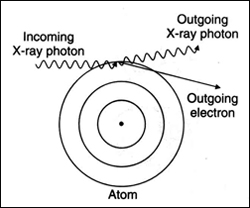

Here, h = Planck’s constant, E k = kinetic energy of electron. So, amount of energy gained by the electron is, That means, the frequency of the scattered photon if will be less than the frequency of the incident photon ‘v’, (v – vˊ) 1). The energy of the diffracted photon will be less than the energy of the incident photon. The lost energy of photon due to collision is equal to the kinetic energy of an electron.

In the figure, Compton Effect has been shown. These charged wavelengths are larger than the wavelength of the initial X-rays. Then within the scattered rays there exists in addition to the incident wavelength X-rays of changed wavelengths are observed. If monochromatic is scattered X-ray by the electron of light exerts e.g., carbon, aluminum etc. Scientist Compton conserving the scattering process of the photon with electron and using the energies of photon and electron and applying conservation principle of momentum found out the change of frequency of wavelength of the photon. This effect is called the Compton Effect or Compton Scattering. So, when a light wave (Photon) is occurrence on an electron, there is reduced in the energy of the photon as a part of energy its primary energy is transferred to the electron which is scattered. This change of wavelength is called Compton Effect. That means the wavelength of the scattered photon will be more than the wavelength of the incident photon.

Due to the transfer of energy of photon the energy of the scattered photon becomes less than the energy of the incident photon. As a result, some amount of energy of the photon decreases. The Compton effect also describes one of the most fundamental phenomena - the interaction of light with matter.After the establishment of the quantum theory of light, scientist Compton proposed in 1925 that if there is a collision between a powerful photon and a particle of matter electron, then the photon gives some energy to the electron. It also gives evidence to Einstein's theory that light is a particle since this equation is exactly consistent with Einstein's idea that the X-ray photon collides with the electron as if it were a particle.įor many physicists, the Compton effect provided the final piece of evidence they needed to finally accept Einstein's idea of the particle nature of light. The missing energy was found in the lower energy, lower frequency and longer wavelength x-ray photons that were scattered. Instead, the electrons ejected into the air having less kinetic energy than expected. It was previously thought that photons do not have a mass and therefore cannot have a momentum.Īfter the photoelectric effect was discovered Compton shot x-ray photons at metal thinking the higher energy and higher frequency of the wavelength would cause photoelectrons with greater kinetic energy. The electron gains momentum if it gains kinetic energy, the exact amount as the x-ray photon loses in the collision. In order to uphold the law of conservation of energy:Į = hc/⋋.for energy of x-ray photonĮnergy of x-ray = energy of electron + energy of x-ray The total energy of the incident X-ray photon and the electron must equal the total energy of the scattered X ray and the scattered electron. The total momentum of the incident X-ray photon must equal the total momentum of the scattered X ray and the scattered electron. Compton scattering behaves like an elastic collision between a photon and an electron.

When an electron scatters an X ray, both momentum and energy are conserved. The shorter the light wave, the greater the momentum.Ĭompton was also able to show exactly how the change in wavelength of the scattered X ray is related to the angle through which the X-ray photon is scattered.Ĭompton showed that photons can have momentum, even though they do not have mass, as related via the mass-energy equation, E = mc^2Ĭompton found that the scattered X ray changed its momentum and energy in a way expected of a small particle undergoing an elastic collision with an electron. M = E/c^2 and m = p/v (classic momentum equation)Į/c^2 = p/c.it is a photon, so substitute velocity for the speed of light. In E = mc^2, mass and energy are different forms of the same thing. By using the particle model of light and Einstein's mass-equivalence equation E = mc^2, Compton showed that the momentum of the X ray could be expressed.


 0 kommentar(er)
0 kommentar(er)
